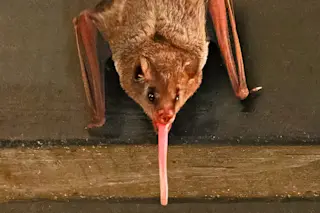(Wikimedia Commons) Nectar-drinking bats possess hairy tongues, and now scientists reveal these hairs are designed to maximize how much sweet nectar the bats can guzzle. The South American Pallas' long-tongued bat, Glossophaga soricina, dips its long tongue in and out of flowers while hovering in mid-air, and the hairs on its tongue apparently helping it collect nectar that pools at the bottom of the blossoms. Other animals, such as honeybees and mouse-like marsupials, known as honey possums, native to Australia similarly possess hairy tongues, but it remained unclear just how much these hairs helped them out with drinking. Mechanical engineer Alice Nasto at MIT and her colleagues previously investigated the way fluid flows over and through hairy surfaces to find out, for instance, that fur coats that entrap insulating pockets of air might one day help keep divers warm under water. This work led them to explore other intersections of ...
This Is Why Some Bats Have Hairy Tongues
Discover how nectar-drinking bats use their hairy tongues to maximize nectar collection with fluid mechanics insights.
More on Discover
Stay Curious
SubscribeTo The Magazine
Save up to 40% off the cover price when you subscribe to Discover magazine.
Subscribe













